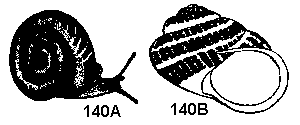
Return to: CFREC Home Page
Adult - An adult shell has 4 to 5 whorls and is 28 to 32 mm in diameter. The shell is large, globose, rather thin, and has fine wrinkles on the surface. It is yellowish or horn-colored with chestnut brown spiral bands that are interrupted by yellow flecks or streaks. The aperture is crescent-shaped or oval-crescent-shaped, approximately one half the shell diameter, and has the tip turned back.
Young - Young brown garden snails are similar in appearance to adults, but are smaller.
Eggs - Brown garden snail eggs are white, spherical, and about 5 mm in diameter.

Fig 140 Brown garden snail. Helix aspersa Miller,
Helicidae, STYLOMMATOPHORA
Brown garden snail (A) and shell opening (B).
Distribution - The brown garden snail is native to Europe and the Mediterranean Region. It was introduced by French immigrants into California, Kentucky, Louisiana, New Mexico, Oregon, South Carolina, Texas, Utah, and Washington.
Host Plants - The brown garden snail is a general feeder and will probably attack anything in a greenhouse.
Damage - The brown garden snail eats large ragged holes in leaves and may totally consume seedlings. Low growing plants generally suffer the most damage, but this snail climbs trees to feed and has been reported as a pest in citrus orchards.
Life History - Eggs are laid in a nest 2.5 to 4 cm deep in the soil. Each snail lays an average of 85 eggs. Eggs hatch in 2 to 4 weeks depending on soil moisture and temperature. The egg mass is concealed by a mixture of soil and secreted mucus, and is then covered with excrement. The number of times a snail oviposits is dependent on temperature, humidity, and soil conditions. Low temperatures (less than 12°C) and low humidity inhibit the activity of the snail. Dry soil is unsuitable for nest preparation.
During warm, damp weather, ovipositions may be as frequent as once a month. Peak activity period is February to October. Each adult snail during this period will oviposit about once every six weeks. During these five ovipositions each snail lays an average of 430 eggs.
When dry conditions prevail, the snail may seal itself to a object or close off the aperture of the shell with parchment-like material. With the return of moist or humid conditions, the snail will again become active.
One control option is to hand pick the snails from plants Place the snails in a jar, fill it with water, put the lid on securely, and let them drown. The addition of dish detergent to the water will kill them faster. Another big help is to clean up the area by removing the hiding places in which the snail spend the day. Sometimes bands of wood ashes or lime are recommended to discourage snails from entering an area. Lime may work as long as it is kept dry, but lime may adversely affect the soil pH. Wood ashes appear to be somewhat effective. Snails will avoid crossing copper screening or banding because the mollusk apparently receive a minute electric shock when it contacts copper.
Reference to University of Florida/IFAS Pest Control Guides